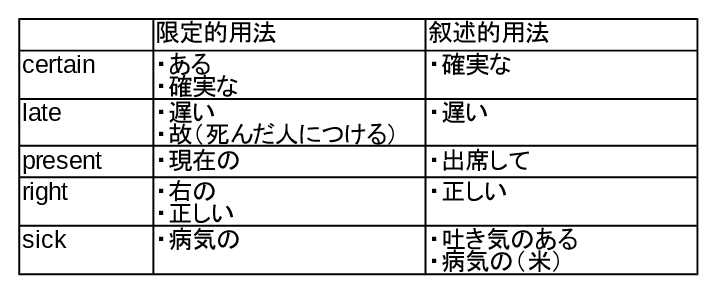形容詞の基本
形容詞の基本(Adjective basics)
スポンサーリンク
アフィリエイト広告を利用しています。
形容詞の用法には、次のように3種類あります。
(1)限定的用法(Attributive use)
(2)叙述的用法(Predicative use)
(3)名詞的用法(Noun use)
1. 限定的用法
(1)形容詞が名詞の前に置かれて、名詞を修飾する使い方を、限定的用法といいます。
“young men”(若い人々),”hot water”(お湯),”fine weather”(晴天)・・・
(2)形容詞が名詞の後につく場合もあります。
1)形容詞に他の語が付き、まとまった句となっている場合
“a child four years old“(4歳の子供),”time enough and to spare”(有り余る時間)
2)相対的な比較をする形容詞を並べる場合
○ He wrote many stories, noble and ignoble, moral and immoral.
「彼は上品な、また下品な、道徳的な、また不道徳な多くの物語を書きました。」
3) “something”,”anything”,”nothing”,”everything” など、”-thing” の付く語の場合
○ Do you have anything good?
「何かいいことありますか」
○ Yes, I have something nice.
「はい、いいことありますよ。」
4)固有名詞に区別のためにつける場合
“Japan proper”(日本本土),”Asia Minor”(小アジア),”George the Second”(ジョージ2世)
5)フランス語流の決まった言い方に使う場合
“the sum total”(合計),”from time immemorial”(太古の昔から),”the poet laureate”(桂冠詩人)
6)次のような形容詞が付く場合
・present: ”the students present”(居合わせた学生たち)
・opposite: ”the house opposite”(向こう側の家)
・worth: ”a man worth a billion”(億万長者)
(3)限定的用法にのみ使われる形容詞
次のような形容詞は、限定的用法のみで使用されます。
1)材料を表すもの:
“a wooden leg”(木製の足),”earthen ware”(土器)
2)関係を表すもの:
“my right hand”(右手),”your left ear”(左耳),”his elder sister”(彼の姉)
3)その他:
“spare time”(暇な時),”a mere boy”(まだほんの少年),”an only child”(一人っ子)
(4)形容詞の順序について
複数個の形容詞を名詞の前につけるとき、その順序はおおよそ次のようになります。
1)代名形容詞 + 数量形容詞 + 性状形容詞 + 名詞
“those three old man”,(それら3人の老人たち)
2)性状形容詞が複数つく場合は、語調を主として考えます。ただし、固有名詞は名詞の直前に置きます。
“a pretty little gold ring”,(きれいな小さい金の指輪)
“those five clever English girls”,(あの利口なイギリス少女)
“a beautiful little new white wooden horse”,(美しい小さな新しい白い木馬)
3)同じ種類の形容詞を、等位接続詞(and,or,butなど)を最後の形容詞の前に入れてコンマでつなぐことがあります。
“A kind, clever, and diligent boy”,(親切で、利口で勤勉な少年)
(5)前置詞句、分詞句、形容詞節は、それらが修飾する名詞の後に付きます。
1)前置詞句(形容詞句):
“the book on the table”(テーブルの上の本),”the bus for the Zoo”(動物園行きのバス)
2)分詞句:
“the boy standing by the gate”(門の側に立っている少年),”a letter written in English”(英語で書かれた手紙)
3)形容詞節(関係詞節):
“the policeman who showed me the way”(道を教えてくれた警官),”the house [that] Jack built”(ジャックが建てた家)
2.叙述的用法
(1)形容詞が動詞の補語として使用され、名詞や代名詞を修飾しない使い方を叙述的用法といいます。第二文型(S+V+C)や第5文型(S+V+O+C)のCに相当する使い方です。
○ Yesterday was very fine.
「昨日は快晴でした。」 (第二文型)
○ She made me happy.
「彼女は私を幸せにした。」 (第五文型)
(2)叙述的用法にのみしか使えない形容詞
1)接頭語”a-”が付く語:
“alone”(一人で),”alive”(生きて),”asleep”(眠って),”ashamed”(恥じて)
○ Her baby is now fast asleep.
「彼女の赤ちゃんは、今ぐっすり眠っています。」
2)その他:
proof: ”He is proof against flattery.”(彼はおだてにのらない人です。)
wont: ”He was wont to do so.”(彼はそうする習慣でした。)
content: ”I am content to do so.”(彼は甘んじてそうします。)
well: ”I am very well.”(彼は非常に健康です。)
(3)用法により意味が異なる形容詞
限定的用法と叙述的用法とによって、意味が異なるものがあります。

3. 名詞的用法
(1)”the + 形容詞” は名詞の意味に用いられます。
1)複数普通名詞
○ The rich ( = Rich people ) are apt to despise the poor ( = poor people ).
「富裕層は貧困層を軽蔑する傾向があります。」
○ The killed and the wounded were left on the field.
「死者や負傷者はその場に取り残されました。」
2)単数普通名詞
単数の意味で使うことはまれです。
○ The deceased was a great scholar.
「故人は大学者でした。」
3)抽象名詞
○ It is an essay on the sublime and the beautiful.
「それは崇高と美に関する論文です。」
○ We must distinguish between the false and the true.
「嘘と真実とは識別しなければなりません。」
4)ものの一部を表す名詞
”the white of an egg”(卵の白身),”the middle of a river”(川の中央部),”the small of the back”(腰部)
(2)”前置詞 + (the +) 形容詞 ” の形の慣用句では、形容詞が名詞の役割をします。
1)時: ”at last”(最後に),”of old”(昔の),”before long”(近いうちに)
2)場所: ”on high”(天井に),”on the right”(右側に)
3)態度: ”in the right”(正当で),”in the wrong”(誤って)
4)程度: ”in full”(残らず),”on the whole”(大体において)
5)状態: ”at best”(せいぜい),”on the alert”(油断なく)
(3)接続詞または前置詞でつながれた対になる語の形容詞は名詞の役割をします。
“the long and the short”(要点),”from first to last”(初めから終わりまで),”high and low”(貴賤),”young or/and old”(老いも若きも)
(4)名詞化した形容詞
“a noble / nobles”(貴族),”a native / natives”(土着人),”elders”(年長者)
参考
英語ニューハンドブック 研究社
英文法の泉 http://www.e-bunpou.net/keiyousi-kihon.html
ORG:2017/10/22